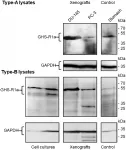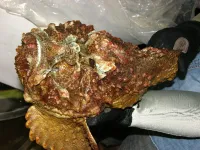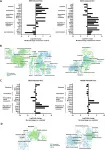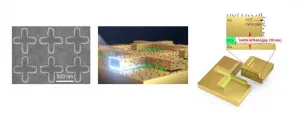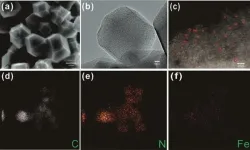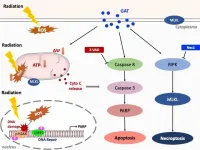(Press-News.org) Neutrons - Space ice, un-Earthly cold
Researchers from NASA's Jet Propulsion Laboratory and Oak Ridge National Laboratory successfully created amorphous ice, similar to ice in interstellar space and on icy worlds in our solar system. They documented that its disordered atomic behavior is unlike any ice on Earth.
The findings could help interpret data from future NASA missions such as Europa Clipper, which will assess the habitability of Jupiter's moon, Europa.
Using the Spallation Neutron Source's SNAP instrument, the scientists replicated the cold vacuum of space and added a few molecules at a time of heavy water to a plate cooled to 25 Kelvin to produce amorphous ice. They then used neutron scattering to observe the ice's structural changes at varying temperatures before it transitioned to crystalline ice.
"Amorphous water ice is ubiquitous in the universe, yet isn't well understood. Our data could help understand exotic ice forms in our solar system and beyond," said ORNL's Chris Tulk.
Media contact: Paul Boisvert, 502.229.4466, boisvertpl@ornl.gov
Image: https://www.ornl.gov/sites/default/files/2021-06/EuropaClipper_Poster_08_2020_002_2_.jpg
Caption: ORNL and NASA's Jet Propulsion Laboratory scientists studied the formation of amorphous ice like the exotic ice found in interstellar space and on Jupiter's moon, Europa. Credit: NASA/JPL-Caltech
Buildings - In the loop
Researchers at Oak Ridge National Laboratory have developed a novel envelope system that diverts heat or coolness away from a building and stores it for future use.
Traditional building envelopes, such as roofs and walls, use insulation to reduce heat flow. ORNL's thermally anisotropic building envelope, or TABE, adds thin conductive layers between the insulation. The conductive layers connect to a thermal loop that redirects the heat or coolness to an energy storage system.
Stored energy is then used to heat or cool the indoor space. Sensors and controls determine when to transfer energy between the envelope and the loop to maximize energy savings or peak load reductions.
"Our simulations predicted more than 50% energy savings in a residential building," ORNL's Som Shrestha said. "Results from a one-year field demonstration also showed promising results for TABE when used in walls and roofs."
Media contact: Jennifer Burke, 865.414.6835, burkejj@ornl.gov
Image/Video: https://www.ornl.gov/sites/default/files/2021-06/wall_drop_high_res_longer.gif
Caption: ORNL researchers developed an innovative insulation system that uses sensors and controls to exchange heat or coolness between a building and its thermal energy storage system, which maximizes energy savings. Credit: Andrew Sproles and Michelle Lehman/ORNL, U.S. Dept. of Energy
Recycling - Batteries unbound
Scientists at Oak Ridge National Laboratory have developed a solvent that results in a more environmentally friendly process to recover valuable materials from used lithium-ion batteries, supports a stable domestic supply chain for new batteries and keeps old ones out of landfills.
Spent batteries are typically broken down using smelting, an expensive, energy-intensive process that releases toxic gas. The ORNL-developed alternative is a wet chemical process using triethyl phosphate to dissolve the binder material that adheres cathodes to metal foil current collectors in Li-ion batteries. The result is efficient recovery of cobalt-based cathodes, graphite and other valuable materials like copper foils that can be repurposed in new batteries.
"With this solvent, we're able to create a process that reduces toxic exposure for workers and recovers valuable, undamaged, active NMC [nickel-manganese-cobalt] cathodes, clean metal foils and other materials that can be easily reused in new batteries," said ORNL's Ilias Belharouak.
Media contact: Stephanie Seay, 865.576.9894, seaysg@ornl.gov
Image: https://www.ornl.gov/sites/default/files/2021-06/metal_03_0.jpg
Caption: ORNL's green solvent enables environmentally friendly recycling of valuable Li-ion battery materials. Credit: Andy Sproles/ORNL, U.S. Dept. of Energy
Geothermal - Design and 3D print
Additive manufacturing can make the design and production of specialized tools for geothermal energy cheaper and more efficient, according to a study by Oak Ridge National Laboratory.
Geothermal is a renewable energy resource that requires specialized tools for drilling in harsh subsurface environments. The tools are typically produced in low quantities at high cost using conventional fabrication.
By using 3D-printing techniques, geothermal companies can take advantage of computer-aided technologies to design tools with enhanced performance characteristics. Those custom parts can then be printed using ORNL's high-strength alloys at a lower cost, especially when printing multiple parts in a single build. The lab's techno-economic analysis found ample opportunity to lower the cost of geothermal projects while improving system performance using additive manufacturing.
"The study points to the significant benefits of additive manufacturing and provides a roadmap for future work, including the development of new AM feedstocks based on advanced, high-temperature alloys," said ORNL's Yarom Polsky.
Media contact: Stephanie Seay, 865.576.9894, seaysg@ornl.gov
Image: https://www.ornl.gov/sites/default/files/2021-06/geothermal-3dprinting.jpg
Caption: By using computer-aided design and additive manufacturing, developers can improve the performance characteristics of geothermal tools, such as this optimized rotor design, and reduce production cost. Credit: ORNL, U.S. Dept. of Energy
INFORMATION:
Single atomic defect is the smallest structural unit of solid material. The construction of devices based on single defect can reach the limit of miniaturization of semiconductor devices. In the past decades, the creation and manipulation of single defects in semiconductors opened a new research field, and could be used to physically realize "qubits" of solid-state quantum computation through spin or electron charge. Most interest have focused on the studies of spin quantum computing. However, the spin manipulation need an optical and magnetic field. On the contrary, multiple ...
Leipzig. The smoke from the extreme forest fires on the US West Coast in September 2020 travelled over many thousands of kilometres to Central Europe, where it continued to affect the atmosphere for days afterwards. A comparison of ground and satellite measurements now shows: The forest fire aerosol disturbed the free troposphere over Leipzig in Germany as never before. An evaluation by an international research team led by the Leibniz Institute for Tropospheric Research (TROPOS) revealed an extraordinary optical thickness on 11 September 2020, which attenuated ...
Oncotarget published "Development of a ghrelin receptor inverse agonist for positron emission tomograph" which reported that imaging of Ghrelin receptors in vivo provides unique potential to gain deeper understanding on Ghrelin and its receptors in health and disease, in particular, in cancer.
Ghrelin, an octanoylated 28-mer peptide hormone, activates the constitutively active growth hormone secretagogue receptor type 1a with nanomolar activity.
The authors developed novel compounds, derived from the potent inverse agonist K- -FwLL-NH2 but structurally varied by lysine conjugation ...
Oncotarget published "Global DNA hypermethylation pattern and unique gene expression signature in liver cancer from patients with Indigenous American ancestry" which reported that contrasting with this pattern, the age structure of HCC in Andean people displays a bimodal distribution with half of the patients developing HCC in adolescence and early adulthood.
To deepen the understanding of the molecular determinants of the disease in this population, the authors conducted an integrative analysis of gene expression and DNA methylation in HCC developed by 74 Peruvian patients, including 39 adolescents and young adults.
While genome-wide hypomethylation ...
New research from the Prevention Research Center of the Pacific Institute for Research and Evaluation, The Ohio State University, and San Jose State University finds that during COVID-19 stay-at-home orders, parental stress was higher during the workday compared to after the workday and lower during weekends than during weekdays.
Previous research compares parental stress before and during the pandemic, but none has measured it during stay-at-home orders. In this study, scientists assessed how time-varying and day-varying factors are related to parents' level of stress. In specific, stress was examined 3 times a day for 14 days for survey participants in Ohio from April to May 2020.
Specific findings include:
Parents ...
University of Queensland scientists working to unlock the mysteries Australia's deadly stonefish have made a discovery which could change how sting victims are treated in the future.
Stonefish are the most venomous fish in world and are found throughout shallow coastal waters of the northern half of Australia.
Study co-author Associate Professor Bryan Fry said previous studies have not been able to uncover all of the mechanisms at play in stonefish venom because of the way the venom was tested.
"There's a couple of reasons previous studies haven't been able to thoroughly decipher the toxicological mysteries of stonefish venom," Dr Fry said.
"But ...
Oncotarget published "Multi-modal effects of 1B3, a novel synthetic miR-193a-3p mimic, support strong potential for therapeutic intervention in oncology" which reported that the authors comprehensively investigated miRNA-193a-3p's mode of action in a panel of human cancer cell lines, with a variety of genetic backgrounds, using 1B3, a synthetic microRNA mimic.
Interestingly, the exact mechanism through which 1B3 reduced cell proliferation varied between cell lines.
1B3 efficiently reduced target gene expression, leading to reduced cell proliferation/survival, cell cycle arrest, induction of apoptosis, increased cell senescence, DNA damage, and inhibition of migration.
SiRNA ...
A local research team, comprised of members of the Korea Institute of Machinery and Materials(KIMM) under the Ministry of Science and ICT and UNIST, developed a metamaterial absorber that significantly enhances the detection of harmful substances or biomolecules, and published their results in Small Methods.
The joint research team led by Principal Researcher Dr. Joo-Yun Jung of the Nano-Convergence Mechanical Systems Research Division at KIMM and Professor Jongwon Lee of UNIST developed a metamaterial that enhances infrared absorption spectroscopy through 100-fold amplification of detection signals. The proposed metamaterial is a special functional material with vertical nanogaps of a smaller size than infrared wavelength.
Infrared spectroscopy is a technique that identifies ...
Recently, the research team led by Prof. KONG Lingtao from Institute of Solid State Physics, Hefei Institutes of Physical Science (HFIPS) prepared a highly active single iron atom catalyst (Fe-ISAs@CN) which can activate H2O2 to generate free radicals, achieving rapid removal of sulfadiazine pollutants in aqueous. The relevant results were published in Journal of Colloid and Interface Science.
Sulfadiazine (SDZ), a kind of synthetic sulfadiazine antibiotic, is widely used in clinical and animal husbandry industries. However, due to its large-scale use and unqualified discharge of wastewater, more and more antibiotic residues ...
Recently, the research team led by Prof. KONG Lingtao from Institute of Solid State Physics, Hefei Institutes of Physical Science (HFIPS) prepared a highly active single iron atom catalyst (Fe-ISAs@CN) which can activate H2O2 to generate free radicals, achieving rapid removal of sulfadiazine pollutants in aqueous. The relevant results were published in Journal of Colloid and Interface Science.
Sulfadiazine (SDZ), a kind of synthetic sulfadiazine antibiotic, is widely used in clinical and animal husbandry industries. However, due to its large-scale use and unqualified discharge of wastewater, more and more antibiotic residues are detected in the ...



